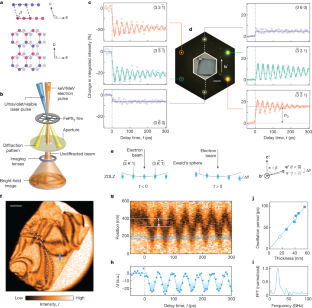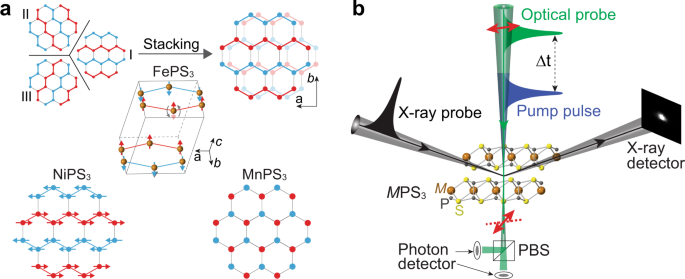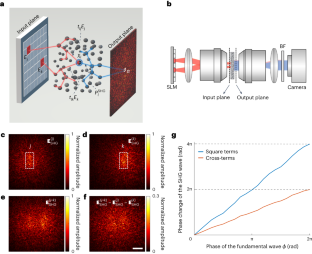2023-08-02 アルゴンヌ国立研究所(ANL)
◆この応答は10から100ピコ秒で行われるため、ナノスケールデバイスへの応用が期待されています。生体医療応用の高速ナノモーターやナノロボットなどの分野に重要な影響を及ぼす可能性があります。これらの研究は、最新の超高速プローブを使用して行われ、世界クラスの科学的施設で行われました。
<関連情報>
- https://www.anl.gov/article/scientists-discover-unusual-ultrafast-motion-in-layered-magnetic-materials
- https://www.nature.com/articles/s41586-023-06279-y
- https://www.nature.com/articles/s41467-022-34376-5
ファンデルワールス反強磁性体におけるスピンを介したシア振動子 Spin-mediated shear oscillators in a van der Waals antiferromagnet
Alfred Zong,Qi Zhang,Faran Zhou,Yifan Su,Kyle Hwangbo,Xiaozhe Shen,Qianni Jiang,Haihua Liu,Thomas E. Gage,Donald A. Walko,Michael E. Kozina,Duan Luo,Alexander H. Reid,Jie Yang,Suji Park,Saul H. Lapidus,Jiun-Haw Chu,Ilke Arslan,Xijie Wang,Di Xiao,Xiaodong Xu,Nuh Gedik & Haidan Wen
Nature Published:02 August 2023
DOI:https://doi.org/10.1038/s41586-023-06279-y

Abstract
Understanding how microscopic spin configuration gives rise to exotic properties at the macroscopic length scale has long been pursued in magnetic materials1,2,3,4,5. One seminal example is the Einstein–de Haas effect in ferromagnets1,6,7, in which angular momentum of spins can be converted into mechanical rotation of an entire object. However, for antiferromagnets without net magnetic moment, how spin ordering couples to macroscopic movement remains elusive. Here we observed a seesaw-like rotation of reciprocal lattice peaks of an antiferromagnetic nanolayer film, whose gigahertz structural resonance exhibits more than an order-of-magnitude amplification after cooling below the Néel temperature. Using a suite of ultrafast diffraction and microscopy techniques, we directly visualize this spin-driven rotation in reciprocal space at the nanoscale. This motion corresponds to interlayer shear in real space, in which individual micro-patches of the film behave as coherent oscillators that are phase-locked and shear along the same in-plane axis. Using time-resolved optical polarimetry, we further show that the enhanced mechanical response strongly correlates with ultrafast demagnetization, which releases elastic energy stored in local strain gradients to drive the oscillators. Our work not only offers the first microscopic view of spin-mediated mechanical motion of an antiferromagnet but it also identifies a new route towards realizing high-frequency resonators8,9 up to the millimetre band, so the capability of controlling magnetic states on the ultrafast timescale10,11,12,13 can be readily transferred to engineering the mechanical properties of nanodevices.
ファンデルワールス反強磁性体におけるスピン-シア結合の動的臨界性 Dynamical criticality of spin-shear coupling in van der Waals antiferromagnets
Faran Zhou,Kyle Hwangbo,Qi Zhang,Chong Wang,Lingnan Shen,Jiawei Zhang,Qianni Jiang,Alfred Zong,Yifan Su,Marc Zajac,Youngjun Ahn,Donald A. Walko,Richard D. Schaller,Jiun-Haw Chu,Nuh Gedik,Xiaodong Xu,Di Xiao & Haidan We
Nature Communications Published:03 November 2022
DOI:https://doi.org/10.1038/s41467-022-34376-5

Abstract
The interplay between a multitude of electronic, spin, and lattice degrees of freedom underlies the complex phase diagrams of quantum materials. Layer stacking in van der Waals (vdW) heterostructures is responsible for exotic electronic and magnetic properties, which inspires stacking control of two-dimensional magnetism. Beyond the interplay between stacking order and interlayer magnetism, we discover a spin-shear coupling mechanism in which a subtle shear of the atomic layers can have a profound effect on the intralayer magnetic order in a family of vdW antiferromagnets. Using time-resolved X-ray diffraction and optical linear dichroism measurements, interlayer shear is identified as the primary structural degree of freedom that couples with magnetic order. The recovery times of both shear and magnetic order upon optical excitation diverge at the magnetic ordering temperature with the same critical exponent. The time-dependent Ginzburg-Landau theory shows that this concurrent critical slowing down arises from a linear coupling of the interlayer shear to the magnetic order, which is dictated by the broken mirror symmetry intrinsic to the monoclinic stacking. Our results highlight the importance of interlayer shear in ultrafast control of magnetic order via spin-mechanical coupling.



